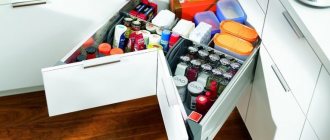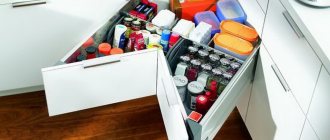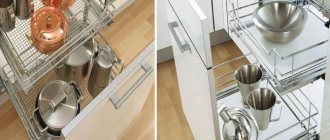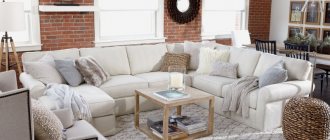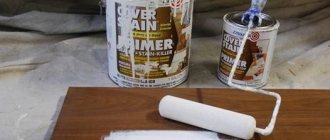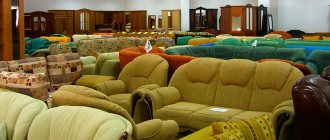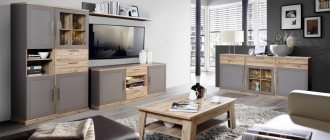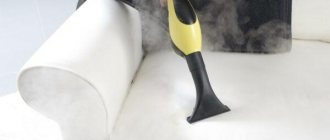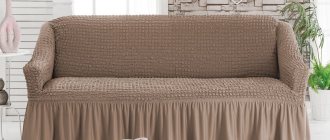Furniture fasteners and fittings help to carry out high-quality assembly of structures from different materials. The types of fastening systems are varied, differing in the method of fixation and the location of their installation.
The fittings not only simplify the process of assembling furniture, but also remain invisible after the work is completed. On the modern market you can find a huge number of fasteners for assembling a variety of furniture, increasing its reliability and service life.
Furniture fasteners and accessories
Accessories for sofas - wheels and supports
Depending on the mechanisms of transformation of sofas, there are two types of support:
- Wheels
- Legs
Wheels for sofas come in various shapes and locations:
- Large
- Average
- Little ones
- Side
- Inside the bracket
- Above
Do not confuse wheels with rollers. Furniture accessories for a sofa wheel are a support on which the unfolded sofa rests. And furniture fittings, rollers for a sofa, are mechanisms that help you unfold and fold the sofa.
The wheels are made of durable polyurethane. When choosing them, you should pay attention to:
- No cracks
- Easy scrolling
The rollers are made of metal and run on a special sleeper
The legs come in different shapes and thicknesses and are made from different materials (wood, plastic, metal).
Types of fastening hardware
Depending on the type of furniture and its purpose, the designs of fastening elements differ. They can:
- fix the product from the inside, creating a strong frame;
- secure the furniture base to the floor or wall.
Each type of fittings has different characteristics and features. Some fasteners will be appropriate for assembling glass furniture, others for chipboard.
Main types of furniture fasteners
Furniture corners
One of the simplest and oldest types of fasteners. Even a novice furniture assembler can handle such a corner. Based on it, you can design and assemble almost any structure. The main advantage is that installation can be carried out with a minimal set of tools, without any specific skills.
Table 1. Main types of furniture corners.
| Material | Description |
| Plastic | Installation is carried out using self-tapping screws. These corners are different:
|
| Metal | They are a part with stiffening ribs. Made in the form of a 90 degree angle. To fix them, you can use screws, couplings from:
|
Often, corners are used to fix all cabinet parts together. This is also a common fitting used to equip cabinet kitchen furniture. The main disadvantage of such fasteners is that they need to be tightened regularly, as they will gradually become loose.
Confirmat
The second name of confirmat is Euroscrews, Euroscrews. This is a fairly easy to install screw that does not require precision. Its installation requires the use of:
- drills;
- screwdriver.
These are the most common type of furniture screws
The confirmat cap is equipped with a connector for a hex key, which is used to tighten the screw. To install it, you need to make two holes in the furniture - the first in the end of the part, the second in the element that needs to be attached. This screw is quite easy to install, so you can drill holes for it immediately before assembling the structure.
Confirmation structure and standard sizes
For installation of the confirmat, a special drill is used. However, according to most craftsmen, such a device is not relevant - it is difficult to work with it, since it regularly:
- gets clogged;
- staggers.
Therefore, to obtain the necessary holes, you can use ordinary drills. The most common is the confirmat size of 7 * 50 millimeters.
Table 2. Advantages and disadvantages of confirmat.
| pros | Minuses |
| 1. Installation does not require special equipment, so assembling the furniture is quite simple. 2. Provides reliable fastening of parts. 3. Withstands heavy loads. 4. Installation is possible using a mallet. | 1. If you do not use plugs that match the color of the furniture, the confirmation hat will be visible. 2. Confirmat cuts threads inside the part, which can cause its deformation. 3. If furniture is assembled using confirmat, it cannot be disassembled more than three times. |
After studying the table, you can see that the confirmat does not cause any difficulties when working with it and provides a reliable screed. However, if possible, it is better to replace it with an eccentric coupler.
With frequent twisting/twisting, the confirmat damages furniture parts, which negatively affects the strength of the entire structure
Dowels
Dowels are wooden cylindrical fasteners, their size is usually 8 * 35 millimeters (length and diameter). The main advantage of these fasteners is that they are invisible from the inside and outside.
Concealed fastening fittings for furniture
Also, dowel fastening has a couple of disadvantages.
- You can only do it once. It is quite difficult to dismantle and reassemble furniture without damaging it.
- Jeweler's precision is required when preparing holes. To comply with this condition, the use of special equipment may be required.
What does a box jig look like?
Instruction No. 1 - how to install a dowel
Installation of this fittings is extremely simple, you just need to follow certain rules.
Step No. 1 – holes for fasteners. Holes must be made in each part using a drill. It is important that they completely coincide with the position of the axis.
The holes for the dowels must be coaxial
Step No. 2 – installation. Dowels must be inserted into the prepared holes on one part. They should only go halfway deep. To increase strength and secure the fasteners, you can add PVA glue to the holes.
Example of how dowels should be inserted
Step No. 3 – furniture assembly. Now you need to secure the second piece of furniture. To do this, you just need to place it on the protruding edge of the dowels.
If everything is done correctly, the dowels will tightly secure the furniture parts
Instruction No. 2 - how to make a jig for dowels yourself
You don’t have to buy a conductor in a store, because it’s quite easy to make it yourself using available materials. It is necessary to take into account that separate templates are required for different diameters of dowels. To create a conductor you will need:
- wooden blank;
- plywood;
- metal tubes;
- drill/screwdriver.
Supplies for a DIY template
Step No. 1 – holes. Through holes should be made in the wooden blocks, it is important that they are located strictly at an angle of 90 degrees. The diameter of the drill must correspond to the dimensions of the metal pipes.
What wooden blanks with holes should look like
Step No. 2 – processing of plywood. You need to cut three rectangular pieces from plywood and make holes in them. The edges of the plywood can be sanded with sandpaper to remove chips.
The width of the plywood sheets must correspond to the size of the bars
Step No. 3 – forming the conductor. It's time to put the whole structure together. To do this, you need to apply epoxy glue to the metal tubes and insert them into the prepared holes in the wooden blocks. When the glue has dried, you can begin fixing the plywood sheets. They can be attached to the beams using PVA.
When the glue on the homemade jig is completely dry, the template will be suitable for use.
Video – Conductor for DIY dowels
Ties
To fasten furniture parts, 2 types of ties are used. They differ from each other in certain features.
Table 3. Types of furniture ties.
| View | Description |
| Eccentric | Such fittings are used exclusively under factory assembly conditions. To install the screed, a special device is required to make an accurate hole. The main advantage of this screed is its invisibility, making the furniture look:
|
| Intersectional | It is presented in the form of a screw with a nut, which allows you to tighten two perpendicular pieces of furniture together. This type of tie is ideal for fixing:
|
Shelf supports
This type of fittings is very diverse. It is usually divided into fasteners for glass and chipboard. Shelves that harmoniously combine two different types of materials look interesting. To obtain a high-quality screed between them, it is necessary to use shelf holders. Such fittings happen:
- with fixation;
- without fixation.
It is better to choose shelf holders only from high-quality material
Table 4. Differences between shelf holders for chipboard and glass.
| Options | For glass | For chipboard |
| Design | Contains screw and rod. | It consists of a self-tapping screw and a holder. |
| Installation | They are fixed to the cabinet walls with screws, and a shelf is placed on the base. | The self-tapping screw needs to be screwed into the wall of the cabinet, and the holder will fix the plane of the shelf. |
| Advantages | It has an attractive appearance and provides reliable fixation of the shelf. | The reliability of the design is ensured by the threads in the cabinet material. |
| Flaws | To protect against loosening and damage, an elastic gasket is required. | Precise holes must be made. It is important that they match on the wall and shelf. |
Shelf holders must match the style of the furniture and be in harmony with other interior items
Bolt nut
For quite a long period of time, a system such as a bolt-nut has been used to connect furniture surfaces. Holes are made in each part for such fasteners. A bolt is inserted into it on one side, and a nut is screwed on the other. Today, such fastening hardware is not used so often, despite its advantages. The bolt head has a semicircular shape, which, after fixation, does not rotate, remaining in a static position.
The bolt nut has lost its relevance with the advent of modern fittings
Despite its ease of operation, the bolt-nut system has shifted to the background after the advent of more modern types of fastening hardware. However, it still remains relevant when assembling furniture, especially for novice craftsmen.
Table 5. Advantages and disadvantages of bolt-nut fasteners.
| pros | Minuses |
Among the advantages of the bolt nut are:
| There are only two disadvantages. 1. Visibility - after installation, such fasteners remain visible. Because of this shortcoming, the bolt-nut has lost its relevance today. 2. The ability to connect exclusively parallel surfaces. |
Video - Main types of furniture connections
Sofa accessories
The accessories for sofas, in general, are all almost the same, but there are also some differences.
Accessories for accordion sofas include:
- Staples
- Wheels
- Corners
- Hardware
In addition, upholstery fittings are required:
- Filler
- Accessories
- The upholstery itself
The furniture for the sofa is Eurobook, book and click-clack. This requires durable legs, rollers and various fillers.
Facades
In a furniture design, all visible parts that face the front or side plane are called facades. Their configuration and color determine the style of the furniture and set the tone for the entire room.
Main types of facades:
- Doors;
- Front walls of drawers;
- Horizontal and vertical decorative overlays;
- Furniture cornices.
The facade can be easily unfastened from the attachment fastening, replaced with a new one and adjusted in vertical, horizontal and inclined positions. Various circumstances lead to the replacement of facade elements ─ careless use, mechanical damage, outdated design, discoloration of the structure due to exposure to ultraviolet radiation. To make furniture with your own hands, they use solid ─ “blind” and prefabricated frame-paneled facade elements.
Most often used for the production of facades:
- Chipboard;
- MDF board;
- Natural wood (solid);
- Furniture board;
- Metal (stainless steel, aluminum);
- Glass.
Budget furniture is made from laminated chipboard. MDF boards make beautiful structures finished with film, paneling or veneer.
Premium products include elements made from natural wood. Today the market offers modern facades made of aluminum profiles. It looks organically with glass, plastic, rattan and other materials. To fill the profiles, genuine leather, textile fibers, and polymer 3D photo printing are used.
Chipboard
Glass
MDF
Furniture board
Natural wood
Metal
For internal filling
In the production of cabinet furniture, kitchen sets, wardrobes and other types of structures, first of all, attention is paid to their functionality. Today, the internal fillers of furniture structures are comfortable and ergonomic. Types of internal filling for kitchen sets:
- Drainer;
- Tray for storing cutlery;
- Mesh basket;
- Rotating carousel;
- Lifting mechanism;
- Bottlemaker;
- Column;
- Bin.
The internal filling of the wardrobe is divided into three parts:
- Main ─ hangers and shelves;
- Upper ─ mezzanine for long-term storage of things and hats;
- Bottom ─ pull-out compartments for storing documents, jewelry, as well as compartments for seasonal shoes.
In wardrobes, the maximum load on the shelves is 70 kg and allows you to store household appliances. T-shirts, jeans, shirts are stored on pull-out shelves. For things that need to be stored on a hanger, a pantograph is installed.
It is attached to the back or sides of the shelf. The pantograph can be extended manually or using the control panel. Without furniture components, it is impossible to assemble structures. The proper, uninterrupted operation and aesthetic characteristics of the product depend on them.
Mechanisms
Designers and design engineers of furniture production are working on new and improving existing mechanisms for the kitchen, cabinet sets and upholstered products. Thanks to lifting systems, opening of façade elements occurs quietly and easily. They can be fixed at any height and in any position. Let's look at the main types of lifts.
- Folding ─ they are used for multi-tiered wall cabinets and double-leaf facades;
- Folding ─ mechanisms are installed on large blind facades of the upper tier, if the design contains overhanging artificial lighting and canopies;
- Vertical ─ raise façade elements upward on any tiers of the suspended structure;
- Rotating mechanisms ─ are able to rotate and stop a solid facade when opening in any position;
- Mechanical ─ they help open the doors in the upper and lower positions;
- Gas elevators or gas lifts ensure smooth opening and closing of façade parts. Automatic gas lifts are not able to fix the opening of doors in a certain position. Gas lifts, the design of which includes step-by-step or frictional openings, have the ability to fix the door at any height. This mechanism is convenient for residents with short stature and high cabinets.
Folding
Rotary
Mechanical
Folding
Gas
Vertical
Types of retractable mechanisms:
- Roller guides are among the simplest and most cost-effective mechanisms. Steel runners slide in them using plastic or rubber-coated rollers. Their design reduces noise when furniture drawers are pulled out;
- Metaboxes are a roller system with two symmetrical metal sides that move along roller guides. They extend the product partially (3/4) or completely by 270-550 mm and withstand a maximum dynamic load of up to 25 kg;
- Ball ─ telescopic guides, which are used by professional furniture makers in their work. The system allows the drawer to open completely and smoothly, it is durable, silent and wear-resistant;
- Tandemboxes are a retractable system that allows the drawer to open with a light hand press on the front.
The choice of a cabinet, chest of drawers, hallway, kitchen depends on the retractable system, since the drawers present in the design are in constant use. When buying upholstered furniture, special attention should be paid to the sofa and its transformation mechanism.
Types of sofa transformation mechanisms:
- Folding;
- Retractable;
- Unfolding.
Main types of construction:
- Eurobook is a durable mechanism with a long service life. Wide seats are not comfortable for short people;
- The book is a simple and durable design that easily transforms a sofa into a sleeping place. It cannot be placed close to the wall, as it requires significant space to unfold;
- French folding bed ─ the system belongs to the guest type. To unfold it, you need to pull the bottom of the sofa and 3 soft elements will extend into the sleeping area. The mechanism is not adapted to frequent transformation. It suits small spaces;
- Roll-out sofa ─ the mechanism consists of two segments, which are located in the structure of the sofa. When the front lower part is extended, the vacated space is taken by the back cushion. The design is compact in size and allows you to get a comfortable place to sleep. But you need to make sure that the rollers do not scratch the floor;
- Accordion is a transformation mechanism that makes the place to sleep high and comfortable. When folded, it is compact, but it requires free space to unfold it. The system is supplemented with linen drawers;
- Dolphin ─ mechanism for a corner sofa. By pulling a special strap, the hidden part of the structure is pulled out, which will complement the sofa seat to form a berth. It is comfortable and spacious;
- Click-clack is an analogue of the “book” mechanism. The difference is that the backrest can be in an intermediate version, which allows a person to be in a semi-lying state. The transformation mechanism requires free space near the wall.
Roll-out
Click-clack
Eurobook
Book
French folding bed
Accordion
Dolphin
Facade dimensions
The construction industry has introduced a wide range of façades with different dimensions to the market. The size of the frame facade depends on the profile, and the dimensions of products made from MDF boards depend on the capabilities of industrial equipment. For example, the minimum height of solid facades has a size of ─ 137-140 mm, a minimum width of ─ 296 mm, and a maximum height of ─ 988-1250 mm and a maximum width of ─ 596-1200 mm. And in frame-panelled facades, the minimum height is 562-573 mm, the minimum width is 296 mm, the maximum width is 596-896 mm and the maximum height is 980-1010 mm. When choosing a facade product, you need to pay attention to the beautiful design, the ability to fit into the interior of the room and the performance characteristics of the materials.
